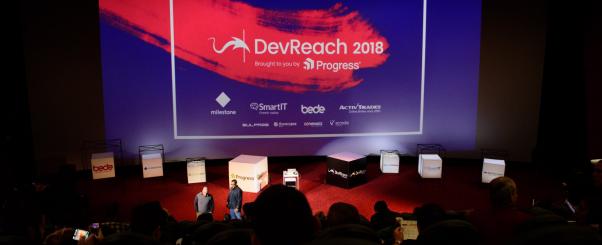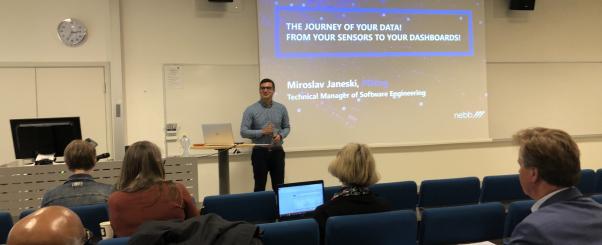 A few weeks ago, I had a chance to attend the DevReach software development conference, which took place on November 12-14 in Sofia, Bulgaria. This year, the conference was a 3-day event with a pre-conference workshop held on the first day and 2 days of conference sessions.
A few weeks ago, I had a chance to attend the DevReach software development conference, which took place on November 12-14 in Sofia, Bulgaria. This year, the conference was a 3-day event with a pre-conference workshop held on the first day and 2 days of conference sessions.
DevReach strives to be the premier developer conference in Central and Eastern Europe. With more than 800 attendees from nearly 20 countries this year DevReach marked its 10th edition. The conference is intended for IT professionals engaged or interested in application development. This event featured world-renowned industry experts who shared their knowledge in a stimulating, enjoyable and friendly atmosphere. As a conference, DevReach offers the ideal opportunity to enhance your proficiency in software application development and boost your confidence.
A few weeks ago, I had a chance to attend the DevReach software development conference, which took place on November 12-14 in Sofia, Bulgaria. This year, the conference was a 3-day event with a pre-conference workshop held on the first day and 2 days of conference sessions.
DevReach strives to be the premier developer conference in Central and Eastern Europe. With more than 800 attendees from nearly 20 countries this year DevReach marked its 10th edition. The conference is intended for IT professionals engaged or interested in application development. This event featured world-renowned industry experts who shared their knowledge in a stimulating, enjoyable and friendly atmosphere. As a conference, DevReach offers the ideal opportunity to enhance your proficiency in software application development and boost your confidence.
I was told that this anniversary edition was going to be special, but before this, I hadn’t had the chance to attend at such a big event. And it lived up to my expectations, there was so much quality content and speakers, that I wished I could have been present in more places at once.
Looking at this year’s agenda, I decided that my focus will be getting updated on .NET technology.
For that reason, I was looking forward to seeing Jon Galloway, who works at Microsoft on ASP.NET, Azure as the Executive Director of the .NET Foundation. I was present at both of his presentations .NET Core Today and Tomorrow and Blazor – A New Framework for Browser-based .NET Apps.
He introduced us with a lot of exiting new stuff in .NET Core 2.1 and .NET Core 2.2. The key focus was on performance improvements and I must say, performance using .NET Core was improved to satisfy different requirements. Also, he presented an early look at .NET Core 3.0 and experimental Blazor project which is set to run .NET code in the browser with WebAssembly.
Blazor is a new experimental web UI framework from the ASP.NET team that aims to bring .NET applications into all browsers (including mobile) via WebAssembly. It allows us to build true full-stack .NET applications, sharing code across server and client, without the need for transpilation or plugins.
There were a few demos, some of them failed during presentation but it was nice to have the chance to look at something new. Jon Galloway presented a modern, component-based architecture (inspired by modern SPA frameworks) at work, as we use it to build a responsive client-side UI. It covered both basic and advanced scenarios using Blazor’s components, router, DI system, JavaScript interop.
In my opinion, the disadvantage of using Blazor I must say is bandwidth, a lot of data was transferred on request between server and client. There was almost 1 MB data transferred between server and client on initial request. Will it be accepted by developers? I guess it will be used in small applications when there is no need for client-side developer experts.
Interesting topics were presented by Jeremy Likness, a Cloud Developer Advocate for Azure at Microsoft. He presented us with one of the most interesting topics these days, Cosmos DB and Serverless .NET technology.
Hiker’s guide to the Cosmos (DB) was presented to introduce us with Cosmos DB. In his experience, developers are daunted by the triple punch of giving up relational databases like SQL, allowing their data to live in the cloud, and moving from hands-on hardware to turnkey solutions. He showed us multi-model structure of Cosmos database and its benefits. With the click of a button, Azure Cosmos DB enables you to elastically and independently scale throughput and storage across any number of Azure's geographic regions. It offers throughput, latency, availability, and consistency guarantees with comprehensive service level agreements (SLAs), something no other database service can offer.
Another interesting topic by Jeremy Likness was Code First in the Cloud: Serverless .NET with Azure.
The popularity of microservices combined with the emergence of serverless based solutions has transformed how modern developers tackle cloud native apps. Microsoft’s Azure cloud provides a feature known as serverless functions (including Azure Functions and Logic Apps) that let developers stand up to integrated end points leveraging the programming language of their choice without having to worry about the supporting infrastructure. Basically, his examples were how to develop serverless .NET apps and connect them with queues, web requests, and databases or seamlessly integrate with third-party APIs like Twitter and Slack.
I must say, his presentation refreshes our memory and understanding about serverless technology. For some time, we have been using Azure Functions in our applications, but it is always nice to have additional information regarding bottlenecks, if this technology is not used properly.
I have always been amazed by the security of applications. Authentication is one of my favorite topics. That is why I decided to see the presentation by Chris Klug, The Whirlwind Tour of Authentication & Authorization with ASP.NET Core.
Authentication and authorization are not fun topics for most people. It is generally that thing that must be there, but nobody really cares about. And on top of that, every time the requirements are a little bit different. Every time we must figure out how to write all the plumbing to get it done properly. It is security after all.
In ASP.NET Core, Microsoft has made it easy to get it all done. In most cases, it is only a few lines of code and some minor configuration, and you are up and going. However, if you don’t know what you are doing, it can be a daunting task.
For me, his presentation was the best, exactly what we all need, working code and examples, simply outstanding. There were different examples of working types of authorizations, how they are configured and used. There were social logins, local logins, even AD-based logins, which can be used in one of our products that we are working on, where we are using users from Active Directory.
Also, he presented us with token-based logins for securing Web API’s. Everything that we need to properly set and run when it comes to authenticating your users in ASP.NET Core.
I am happy to say that I have found the whole conference experience amazing. It was such a privilege for me to be able to attend, and I must express my thanks to Nebb for allowing me to be part of this year’s event.






